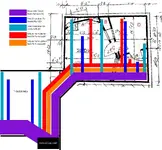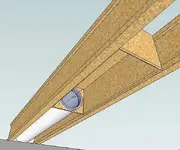Velvet Elvis
Ahh humma humma humma
Pictures - Set 1 of 4
Ok... Here are some pictures to better explain some things:
This first one shows the layout/plan of the studio portion. I am also doing a home theater at the same time, so some of the following pictures will show the theater portion as well.

The next picture shows the existing portion of the basement, entering into the area I am working on (theater and studio)

This next picture is in the theater and shows one of the HVAC vents I was talking about. I can see how I'd caulk around the boot, but it seems like sound would leak left and right out of the actual duct. I AM planning on changing this duct over to flex, to break the metal to metal connection.

This picture shows the theater looking back toward the doorway to the existing part of the basement. The wall to the right is the outside foundation wall. You can also see a portion of the soffit with the OSB to the left that I was mentioning.

This is a picture of the vent boot and the sill plate area that I was mentioning as well.

(more to come in additional posts)
Jim
Ok... Here are some pictures to better explain some things:
This first one shows the layout/plan of the studio portion. I am also doing a home theater at the same time, so some of the following pictures will show the theater portion as well.

The next picture shows the existing portion of the basement, entering into the area I am working on (theater and studio)
This next picture is in the theater and shows one of the HVAC vents I was talking about. I can see how I'd caulk around the boot, but it seems like sound would leak left and right out of the actual duct. I AM planning on changing this duct over to flex, to break the metal to metal connection.
This picture shows the theater looking back toward the doorway to the existing part of the basement. The wall to the right is the outside foundation wall. You can also see a portion of the soffit with the OSB to the left that I was mentioning.
This is a picture of the vent boot and the sill plate area that I was mentioning as well.
(more to come in additional posts)
Jim


 . Hi Jim. Yea. Hey, that plan sure looks familiar.
. Hi Jim. Yea. Hey, that plan sure looks familiar. He really is the expert here.
He really is the expert here. At first glance, its hard to say. Maybe you answered it already but like I said...no time at the moment.
At first glance, its hard to say. Maybe you answered it already but like I said...no time at the moment. You're lucky I'm not saying "the round thing-a-ma-jig".
You're lucky I'm not saying "the round thing-a-ma-jig".


 Yea, all kinds of things to do with sound propogating from fans and turbulance in the ducts themselves. But jesssus, I couldn't find a thing. No wonder Everest described seperate systems.
Yea, all kinds of things to do with sound propogating from fans and turbulance in the ducts themselves. But jesssus, I couldn't find a thing. No wonder Everest described seperate systems.